Accessing Consumer Perceptions of the Effectiveness of the Deposit Refund System
Abstract
1. Introduction
2. Effectiveness of DRS Initiatives and Research Model
2.1. Assessment of the Effectiveness of the DRS Initiatives in Various Countries
2.2. DRS Scheme in Greece
- The consumers: They can purchase a beverage in any retail store in the country, and pay the deposit to the retailer. Once they return the bottle (drink containers in glass, metal, and plastic) to one of the Reverse Vending Machines (RVMs), they receive a recycling ticket with a discount on it for their next purchase. This ticket can be used to purchase any product only at the retail store where the RVMs, “little houses”, are located. There is a refund for each packaging item deposited (EUR 0.03 for one plastic, metal, or glass packaging item).
- The retailers: The stores where Reverse Vending Machines are located. The machines receive and compress the packages/bottles. The RVM also prints out the ticket with the amount of the deposit on it. When the RVMs are full, the retailer empties them and stores the bottles for collection by the DRS administrator.
- The administrator of the DRS practice in Greece “Antapodotiki”: It is a non-profit organization, approved by the Greek Ministry of Environment and Energy, serving exclusively the public interest. Its mission is to organize and promote the recycling of packaging throughout the country. The organization manages all data in the system, claims the deposits from the retailers, and supplies the labels upon request. It oversees the operation and maintenance of the RVMs, the collection and transportation of bottles, the preparation (further compaction), and the temporary storing of bottles in waste treatment facilities. The organization also manages the money flows and transfers revenues to cover the costs (for example, it compensates retailers where the RVMs are located).
- The social solidarity companies who are responsible for the collection, transportation and recycling of packaging.
2.3. Conceptual Framework and Research Model and Hypotheses Development
2.3.1. Motives for the Adoption of Deposit Refund Systems
2.3.2. Perceptions for Adoption of Deposit Refund Systems
| Author(s) | Title of Research Paper | Key Findings |
|---|---|---|
| Vigsø [9] | Deposits on single use containers—a social cost–benefit analysis of the Danish deposit system for single-use drink containers | The new deposit system has considerable social costs in comparison to its benefits. This holds for all four categories of disposable drink containers analyzed, where a comparison was made between the social costs and environmental advantages of gathering these containers through the Danish deposit system and the social costs and benefits of disposing of them as part of the regular waste management system [9]. |
| Miliūtė and Plepys [46] | Driving Forces for High Household Waste Recycling Lessons from Sweden | Creating robust connections and collaboration among the DRS organizations, the municipalities, and the waste management enterprises is crucial. Additionally, it is essential to define and agree upon the responsibilities of each of these parties clearly [46]. |
| Lavee [13] | A cost–benefit analysis of a deposit refund program for beverage containers in Israel | The deposit refund program is clearly worthwhile economically [13]. |
| Dace, Pakere and Blumberga [12] | Evaluation of economic aspects of the deposit refund system for packaging in Latvia | The expenses associated with the Deposit Refund System rely on the amount of packaging that is introduced into the market. Similarly, the amount of packaging that is returned as deposits is dependent on the consumption of beverages. If the Deposit Refund System is implemented, it would result in higher costs for beverage packaging, since manufacturers would be responsible for paying the service fee charged by the system operator to cover its costs [12]. |
| Dāce, Pakere and Blumberga [11] | Analysis of sustainability aspects of the packaging deposit refund system in Latvia | Although the Deposit Refund System can positively influence citizens’ environmental awareness, its benefits must be weighed against its costs. In Latvia, this is particularly difficult to achieve due to the low consumption of beverages. As a result, alternative solutions should be sought to improve the existing curbside container system rather than introducing the Deposit Refund System [11]. |
| Dráb and Slučiaková [17] | Analysis of the introduction of the deposit refund system for single-use beverage packaging in the Slovak Republic | The implementation of a mandatory Deposit Refund System for bottles and cans will not only impact the producers and the system but also lead to indirect and social costs and benefits. On the one hand, it could lead to a reduction in littering, an increase in employment, and environmental benefits. On the other hand, it could result in reduced funding for separate collection and decreased comfort for the population [17]. |
| Linderhof et al. [10] | Effectiveness of deposit refund systems for household waste in The Netherlands: Applying a partial equilibrium model | DRS is more effective at increasing recycling rates in situations where the current recycling rates are relatively low. Additionally, having an existing infrastructure or facility for separate collection would make small goods a suitable candidate for this program [10]. |
| Brizga, Moora and Balcers [18] | DRS for beverage containers in Latvia: learnings within the Baltic states | Estonia and Lithuania have implemented DRS as a means of improving the collection and recycling rates of beverage packaging. Both countries have created mandatory centralized systems with a collection rate of over 90%. The Estonian system’s strengths are due to its sophisticated IT solutions, differentiated European Article Numbering (EAN) coding logic, flexibility, and efficient management. On the other hand, the Lithuanian system is one of the most technologically advanced systems [18]. |
| Abejón et al. [16] | Environmental impact assessment of the implementation of a DRS for packaging waste in Spain: A solution or an additional problem? | Extended Producer Responsibility System (EPRS) is the current practice for packaging in Spain. Although the environmental savings of the new system are superior to its impacts, even if the DRS could reach a value of 90% for the package return index, the current EPRS obtains significantly better environmental results [16]. |
| Oke et al. [43] | Rethinking and optimizing post-consumer packaging waste: A sentiment analysis of consumers’ perceptions towards the introduction of a deposit refund scheme in Scotland | While consumers’ knowledge and view about DRS are mixed, the efficiency of DRS is questioned and raises doubts about its contribution to sustainability. The findings imply a need for the UK to negotiate and collaborate on appropriate and attractive interventions in addressing post-consumer single-use plastic containers [43]. |
| Roca, Ayuso, Bala and Fullana-i-Palmer [41] | What factors determine attitudes towards the implementation of a packaging deposit and refund system? A qualitative study of the perception of Spanish consumers | The public perception of the DRS is very sensitive to the information provided. The description of some of the distinctive features of the new system, such as the mechanism associated with the economic deposit or the process to return packages, ultimately result in a rather negative evaluation and a reduced predisposition to participate in waste collection [41]. |
| Roca et al. [15] | Evaluating the implementation of a packaging Deposit and Refund System in Catalonia. Two surveys on citizenship’s expected behavior | This research examines the results of two surveys: a telephone survey and an online survey that aimed to capture citizens’ evaluations and anticipated behavior changes under the proposed waste collection system. The results of the two surveys differ significantly, with the DRS features receiving more favorable feedback in the telephone survey compared to the online survey. Furthermore, the willingness to adopt the system is higher in the telephone survey [15]. |
| Schröer and Latacz-Lohmann [47] | Farmers’ willingness to engage in a deposit refund system for animal manure in biogas production: A discrete choice experiment in Germany | According to the study’s results, German farmers have shown a high willingness to participate in a Deposit Refund System for animal manure, with an average probability of participation being 70%. The study also suggests that the Deposit Refund System could be an efficient means of distributing nutrients regionally, with an average of 73% of nutrients being returned. Any remaining quantities of nutrient can be transferred to crop farms, possibly for a fee, which can be financed by the retained deposit [47]. |
3. Research Methodology
4. Results and Discussion
4.1. Measuring the Effectiveness of the DRS in Greece
- The machine is out of order.
- The bin is full.
- The machine freezes.
- The instructions are not clear.
- They did not know what products can be recycled.
- They did not have the appropriate support from the supermarket staff.
- Similar packages are sometimes accepted and other times are not.
- They failed to recycle all units/packages.
- The waiting line was too long.
- The recycling/collection points are too far from my house.
4.2. Model Estimation
4.3. Reflective Measurement Model Assessment
4.4. Structural Model Assessment
5. Conclusions
Author Contributions
Funding
Informed Consent Statement
Data Availability Statement
Conflicts of Interest
References
- Brooks, A.L.; Wang, S.; Jambeck, J.R. The Chinese import ban and its impact on global plastic waste trade. Sci. Adv. 2018, 4, eaat0131. [Google Scholar] [CrossRef] [PubMed]
- European Commission. European Green Deal: Putting an End to Wasteful Packaging, Boosting Reuse and Recycling. 2022. Available online: https://ec.europa.eu/commission/presscorner/detail/en/ip_22_7155 (accessed on 10 December 2022).
- European Commission. A European Strategy for Plastics in a Circular Economy; European Commission: Brussels, Belgium, 2018; p. 24.
- Ellen MacArthur Foundation (EMF). New Plastics Economy. Ellen MacArthur Foundation. 2020. Available online: https://www.ellenmacarthurfoundation.org/our-work/activities/new-plastics-economy?gclid=Cj0KCQiAh4j-BRCsARIsAGeV12A8eeRwcKUF5sdaYCrWSE_H3wWUnVH-kqHyFKHlhFnnf9-lbuxduIUaAoA9EALw_wcB (accessed on 10 December 2022).
- EuroCham. Unpacking Deposit Refund Schemes for Singapore. 2021. Available online: https://eurocham.org.sg/wp-content/uploads/2021/12/EV21-1207-Unpacking-Deposit-Refund-Scheme-for-Singapore-KPMG-paper-V3-1.pdf (accessed on 10 December 2022).
- Latchem, R. How Essential Are Deposit Return Schemes? Recycling International. 2019. Available online: https://recyclinginternational.com/plastics/deposit-return-scheme/ (accessed on 10 December 2022).
- Schneider, D.R.; Tomić, T.; Raal, R. Economic Viability of the DRS for Beverage Packaging Waste—Identification of Economic Drivers and System Modelling. J. Sustain. Dev. Energy Water Environ. Syst. 2021, 9, 1080386. [Google Scholar] [CrossRef]
- Reloop and CM Consulting. Deposits System for one Way Beverage Containers: Global Overview. 2016. Available online: https://www.cmconsultinginc.com/wp-content/uploads/2017/05/BOOK-Deposit-Global-24May2017-for-Website.pdf (accessed on 10 December 2022).
- Vigsø, D. Deposits on single use containers-a social cost-benefit analysis of the Danish deposit system for single use drink containers. Waste Manag. Resour. 2004, 22, 477–487. [Google Scholar] [CrossRef]
- Linderhof, V.; Oosterhuis, F.; van Beukering, P.; Bartelings, H. Effectiveness of deposit-refund systems for household waste in The Netherlands: Applying a partial equilibrium model. J. Environ. Manag. 2019, 232, 842–850. [Google Scholar] [CrossRef] [PubMed]
- Dāce, E.; Pakere, I.; Blumberga, D. Analysis of sustainability aspects of the packaging deposit-refund system in Latvia. WIT Trans. Ecol. Environ. 2013, 173, 729–740. [Google Scholar] [CrossRef]
- Dāce, E.; Pakere, I.; Blumberga, D. Evaluation of economic aspects of the deposit-refund system for packaging in Latvia. Manag. Environ. Qual. 2013, 24, 311–329. [Google Scholar] [CrossRef]
- Lavee, D. A cost-benefit analysis of a deposit-refund program for beverage containers in Israel. Waste Manag. 2010, 30, 338–345. [Google Scholar] [CrossRef]
- Goodall, B. DRS Fundamental to Greece Reaching Recycling Targets. 2021. Available online: https://resource.co/article/drs-fundamental-greece-reaching-recycling-targets (accessed on 10 December 2022).
- Roca, M.; Ayuso, S.; Bala, A.; Colomé, R.; Fullana-i-Palmer, P. Evaluating the implementation of a packaging Deposit and Refund System in Catalonia. Two surveys on citizenship’s expected behaviour. Sci. Total Environ. 2022, 806, 150640. [Google Scholar] [CrossRef]
- Abejón, R.; Laso, I.; Margallo, M.; Aldaco, R.; Blanca-Alcubilla, G.; Bala, A.; Fullana-i-Palmer, P. Environmental impact assessment of the implementation of a Deposit-Refund System for packaging waste in Spain: A solution or an additional problem? Sci. Total Environ. 2020, 721, 137744. [Google Scholar] [CrossRef]
- Dráb, J.; Slučiaková, S. Real Price of Deposit. Analysis of the Introduction of the Deposit-Refund System for Single-Use Beverage Packaging in the Slovak Republic; Institute for Environmental Policy-Ministry of Environment of the Slovak Republic: Bratislava, Slovakia, 2018. [Google Scholar]
- Brizga, J.; Moora, H.; Balcers, O. DRS for beverage containers in Latvia: Learnings within the Baltic States, April, Society. Technology. Solutions. In Proceedings of the International Scientific Conference, Florence, Italy, 5–6 September 2019; p. 21. [Google Scholar] [CrossRef]
- Agnusdei, G.P.; Gnoni, M.G.; Sgarbossa, F. Are deposit-refund systems effective in managing glass packaging? State of the art and future directions in Europe. Sci. Total Environ. 2022, 851, 158256. [Google Scholar] [CrossRef]
- Deloitte. Deposit-Refund System: Facts & Myths. 2019. Available online: https://www2.deloitte.com/content/dam/Deloitte/pl/Documents/Brochures/pl_DRS_Brochure_Deloitte.pdf (accessed on 10 December 2022).
- Antapodotiki. Official site of Antapodotiki—Rewarding Recycling. 2019. Available online: https://www.antapodotiki.gr/en/ (accessed on 10 December 2022).
- Janmaimool, P. Application of protection motivation theory to investigate sustainable waste management behaviors. Sustainability 2017, 9, 1079. [Google Scholar] [CrossRef]
- Vimal, K.E.K.; Agarwal, V.; Mathiyazhagan, K. Barriers in the adoption of buyback schemes for used plastic packaging material—A contextual relationship analysis. Resour. Conserv. Recycl. 2022, 178, 106084. [Google Scholar] [CrossRef]
- Sanabria Garcia, E.; Raes, L. Switzerland: Economic Assessment of a DRS (DRS), An Instrument for the Implementation of a Plastics Circular Economy in Menorca. IUCN. 2021, pp. iv+24. Available online: https://www.iucn.org/sites/default/files/2022-08/economic_assessment_of_a_deposit_refund_system_plastics_ce.pdf (accessed on 10 December 2022).
- Fletcher, D.; Hogg, D.; Von Eye, M.; Elliott, T. Examining the Cost of Introducing a DRS in Spain; Final Report for Retorna; Eunomia Research & Consulting Ltd.: Bristol, UK, 2012; pp. 1–73. [Google Scholar]
- Walls, M. Deposit-Refund Systems in Practice and Theory. Resources for the Future Discussion Paper. 2011, pp. 11–47. Available online: http://papers.ssrn.com/sol3/papers.cfm?abstract_id=1980142 (accessed on 10 December 2022).
- Hogg, D.; Fletcher, D.; Elliott, T.; von Eye, M. Have We Got the Bottle? Implementing a Deposit Refund Scheme in the UK: A report for the Campaign to Protect Rural England. September 2010, p. 165. Available online: http://www.bottlebill.org/assets/pdfs/campaigns/UK-CPRE-2010.pdf (accessed on 10 December 2022).
- Tasaki, T.; Numata, D.; Matsumoto, T.; Tojo, N. Reframing the Concept of Collection Systems with Economic Incentives- Based on the Review of Deposit Refund Systems and Point Systems; National Institute for Environmental Studies: Tsukuba, Japan, 2011.
- Fullerton, D.; Kinnaman, T.C. Garbage, Recycling, and Illicit Burning or Dumping. J. Environ. Econ. Manag. 1995, 29, 78–91. [Google Scholar] [CrossRef]
- Hogg, M.A.; Adelman, J.R.; Blagg, R.D. Religion in the face of uncertainty: An uncertainty-identity theory account of religiousness. Personal. Soc. Psychol. Rev. 2010, 14, 72–83. [Google Scholar] [CrossRef]
- Šuškevičė, V.; Kruopienė, J. Improvement of packaging circularity through the application of reusable beverage cup reuse models at outdoor festivals and events. Sustainability 2020, 13, 247. [Google Scholar] [CrossRef]
- Balderjahn, I. Personality variables and environmental attitudes as predictors of ecologically responsible consumption patterns. J. Bus. Res. 1998, 17, 51–56. [Google Scholar] [CrossRef]
- Schwepker, H.; Cornwell, B. An examination of ecologically concerned consumers and their intention to purchase ecologically packaged products. J. Public Policy Mark. 1991, 10, 77–101. [Google Scholar] [CrossRef]
- European Parliament. A European Refunding Scheme for Drinks Containers. 2011. Available online: https://www.europarl.europa.eu/RegData/etudes/note/join/2011/45706/IPOL-AFET_NT(2011)457065_EN.pdf (accessed on 10 December 2022).
- Palmer, L.; Walls, A. Optimal Policies for Solid Waste Disposal: Taxes, Subsidies, and Standards; Graduate School of Business & Government Management, Victoria University of Wellington: Wellington, New Zealand, 1996; Volume 5. [Google Scholar]
- Spiegelman, J. Using Economic Incentives to Control Pollution. Bus. Environ. ISO 14000 Updates 2005, 16, 4–5. [Google Scholar]
- Jacobsen, L.; Pedersen, S.; Thøgersen, J. Drivers of and barriers to consumers’ plastic packaging waste avoidance and recycling—A systematic literature review. Waste Manag. 2022, 141, 63–78. [Google Scholar] [CrossRef]
- Boucher, J.; Billard, G. The Mediterranean: Mare Plasticum; IUCN: Gland, Switzerland, 2020; p. 62. [Google Scholar]
- Videras, J.; Owen, A.L.; Conover, E.; Wu, S. The influence of social relationships on pro-environment behaviors. J. Environ. Econ. Manag. 2012, 63, 35–50. [Google Scholar] [CrossRef]
- Sijtsema, S.J.; Snoek, H.M.; Van Haaster-de Winter, M.A.; Dagevos, H. Let’s talk about circular economy: A qualitative exploration of consumer perceptions. Sustainability 2019, 12, 286. [Google Scholar] [CrossRef]
- Roca, M.; Ayuso, S.; Bala, A.; Fullana-i-Palmer, P. What factors determine attitudes towards the implementation of a packaging deposit and refund system? A qualitative study of the perception of Spanish consumers. J. Environ. Manag. 2020, 270, 110891. [Google Scholar] [CrossRef] [PubMed]
- Boros, A.; Kurdi, R.; Lukács, Z.P.; Sarkady, A.; Banász, Z. Opinion of the Hungarian population on the reform of beverage packaging deposit-refund system. Sustainability 2021, 13, 6373. [Google Scholar] [CrossRef]
- Oke, A.; Osobajo, O.; Obi, L.; Omotayo, T. Rethinking and optimizing post-consumer packaging waste: A sentiment analysis of consumers’ perceptions towards the introduction of a deposit refund scheme in Scotland. Waste Manag. 2020, 118, 463–470. [Google Scholar] [CrossRef] [PubMed]
- Hair, J.F.; Ringle, C.M.; Sarstedt, M. PLS-SEM: Indeed a silver bullet. J. Mark. Theory Pract. 2011, 19, 139–152. [Google Scholar] [CrossRef]
- Sarstedt, M.; Ringle, C.M.; Hair, J.F. Partial Least Squares Structural Equation Modeling. In Handbook of Market Research; Homburg, C., Klarmann, M., Vomberg, A., Eds.; Springer: Berlin/Heidelberg, Germany, 2017. [Google Scholar] [CrossRef]
- Miliūtė, J.; Plepys, A. Driving Forces for High Household Waste Recycling. Lessons from Sweden. Environ. Res. Eng. Manag. 2009, 1, 50–62. [Google Scholar]
- Schröer, D.; Latacz-Lohmann, U. Farmers’ willingness to engage in a deposit-refund system for animal manure in biogas production: A discrete choice experiment in Germany. J. Clean. Prod. 2023, 384, 135574. [Google Scholar] [CrossRef]
- Hu, L.; Bentler, P. Cutoff criteria for fit indexes in covariance structure analysis: Conventional criteria versus new alternatives. Struct. Equ. Model. 1999, 6, 1–55. [Google Scholar] [CrossRef]
- Shmueli, G.; Sarstedt, M.; Hair, J.F.; Cheah, J.-H.; Ting, H.; Vaithilingam, S.; Ringle, C.M. Predictive model assessment in PLS-SEM: Guidelines for using PLSpredict. Eur. J. Mark. 2019, 53, 2322–2347. [Google Scholar] [CrossRef]
- Tencati, A.; Pogutz, S.; Moda, B.; Brambilla, M.; Cacia, C. Prevention Policies Addressing Packaging and Packaging Waste: Some Emerging Trends. Waste Manag. 2016, 56, 35–45. [Google Scholar] [CrossRef]
- Eriksen, M.; Lebreton, L.C.; Carson, H.S.; Thiel, M.; Moore, C.J.; Borerro, J.C.; Galgani, F.; Ryan, P.G.; Reisser, J. Plastic pollution in the world’s oceans: More than 5 trillion plastic pieces weighing over 250,000 Tons Afloat at Sea. PLoS ONE 2014, 9, e111913. [Google Scholar] [CrossRef]
- Rossetti, P. Deposit Refund Systems Are More Effective Than Mandates. Available online: https://www.rstreet.org/research/deposit-refund-systems-are-more-effective-than-mandates/ (accessed on 10 December 2022).
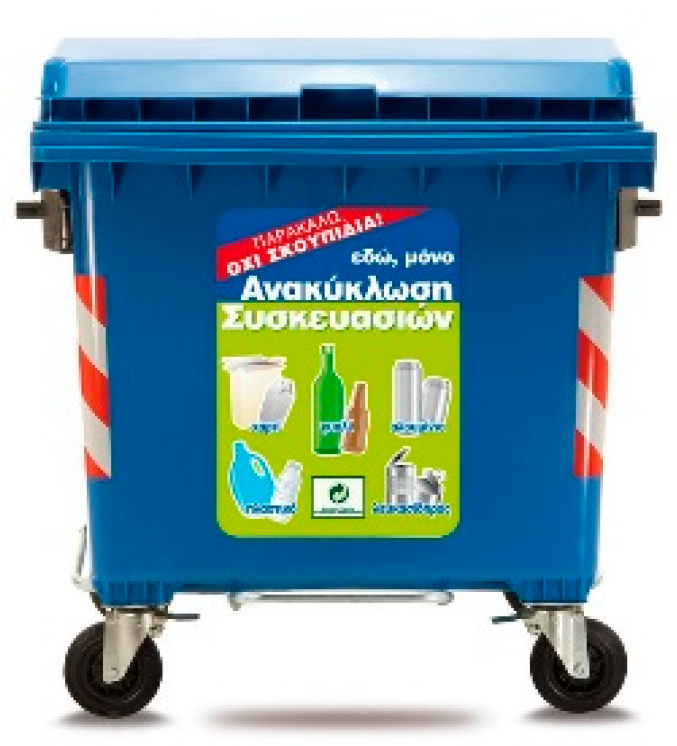
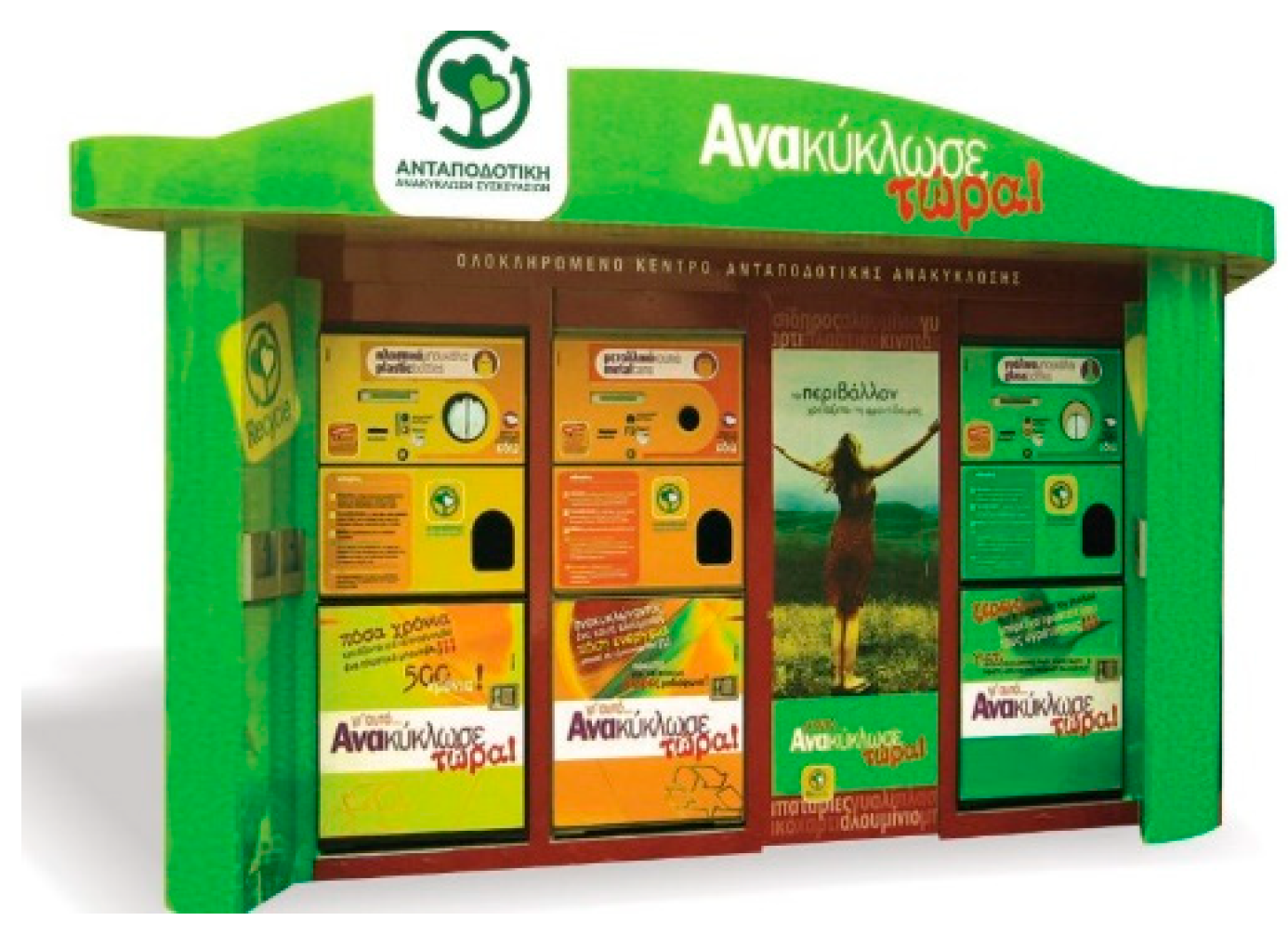
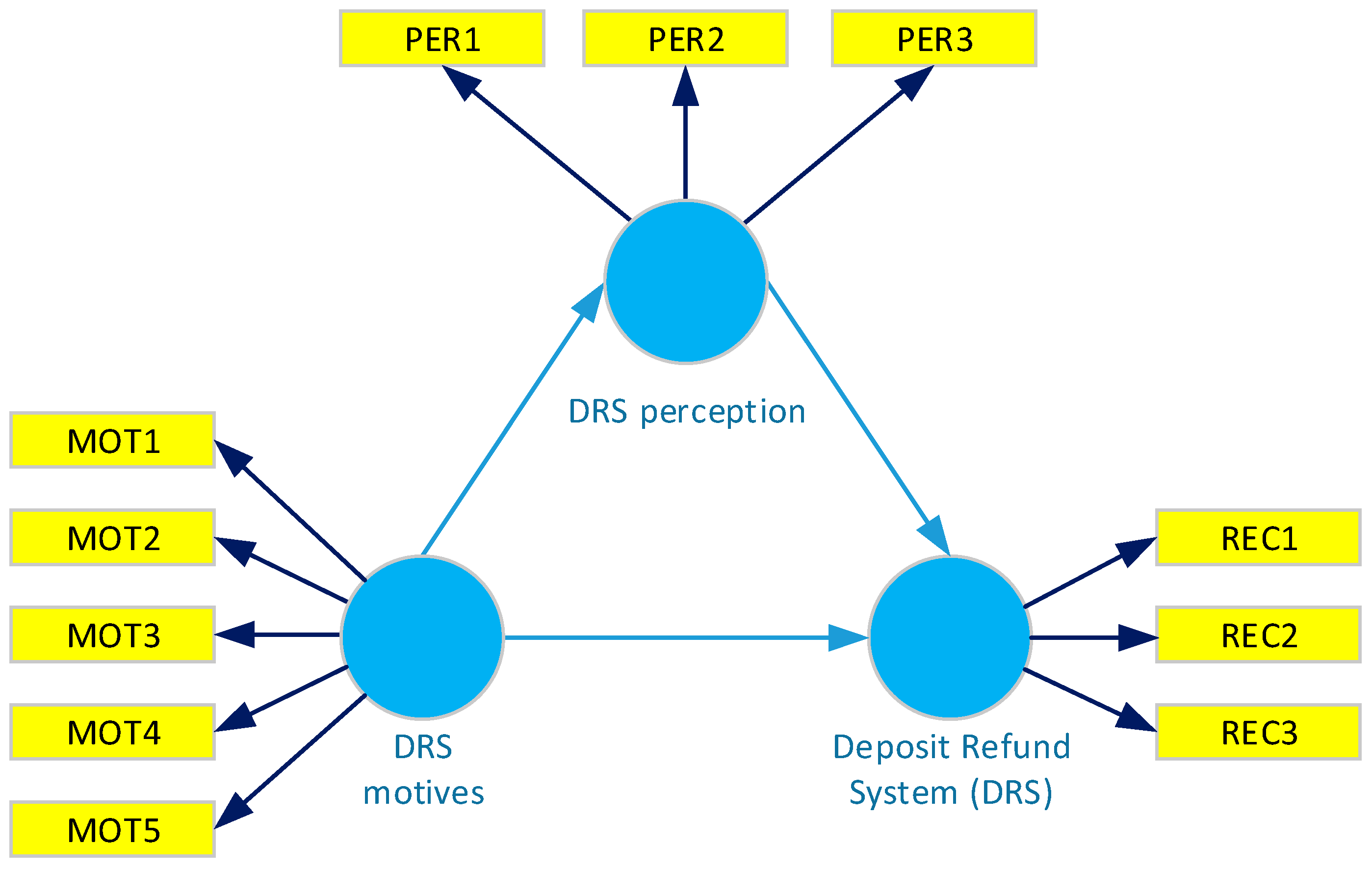
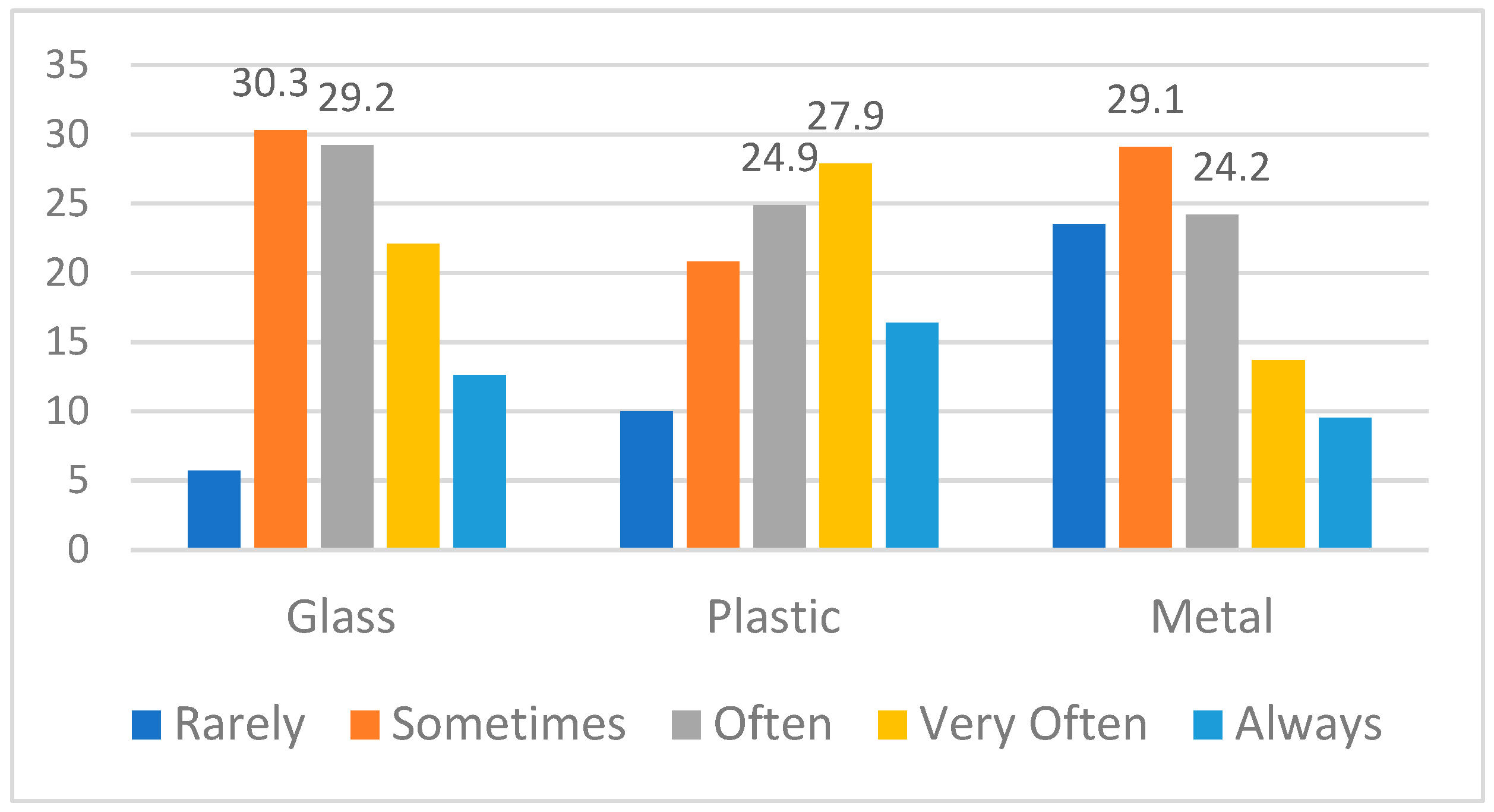
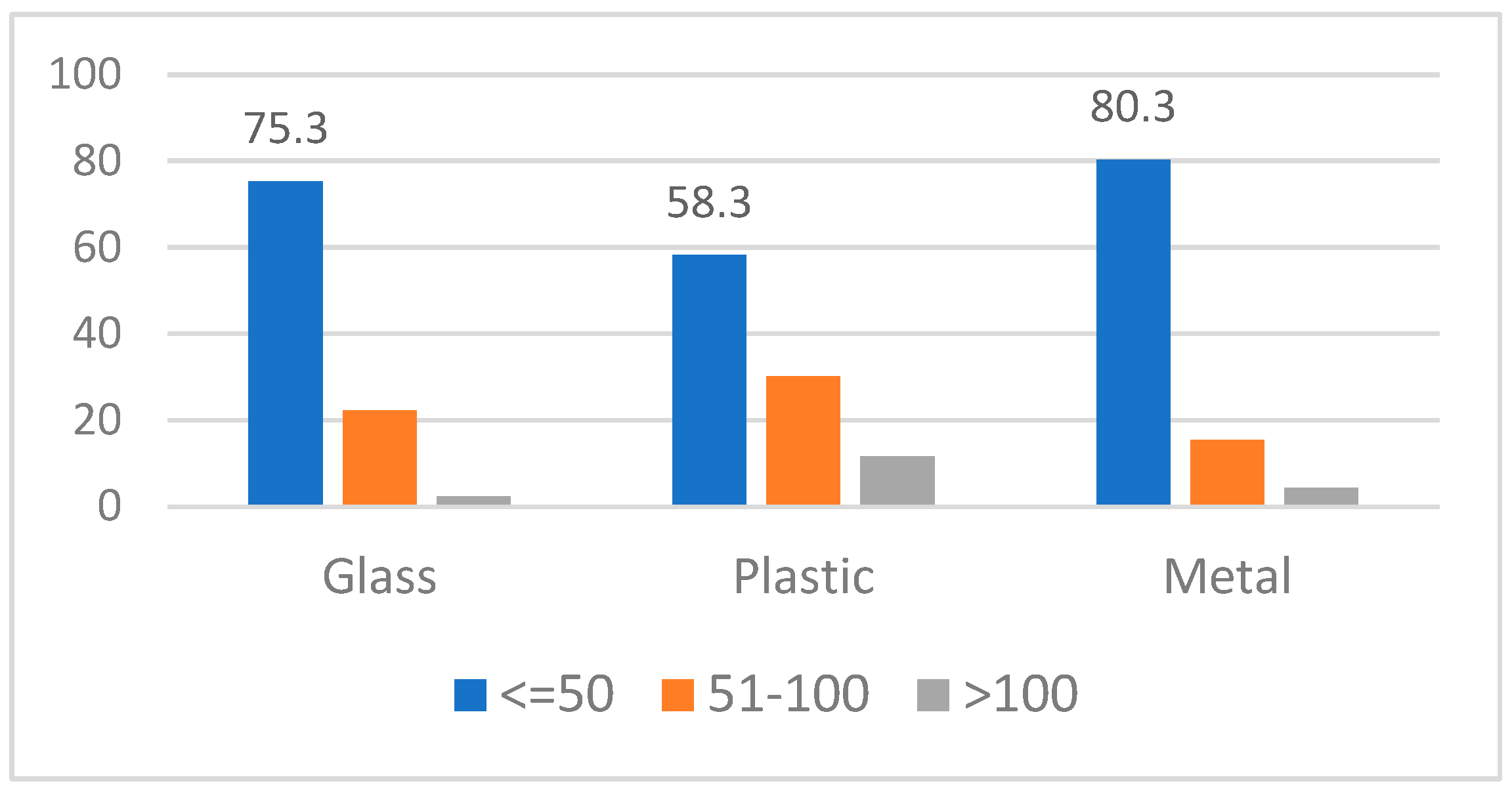
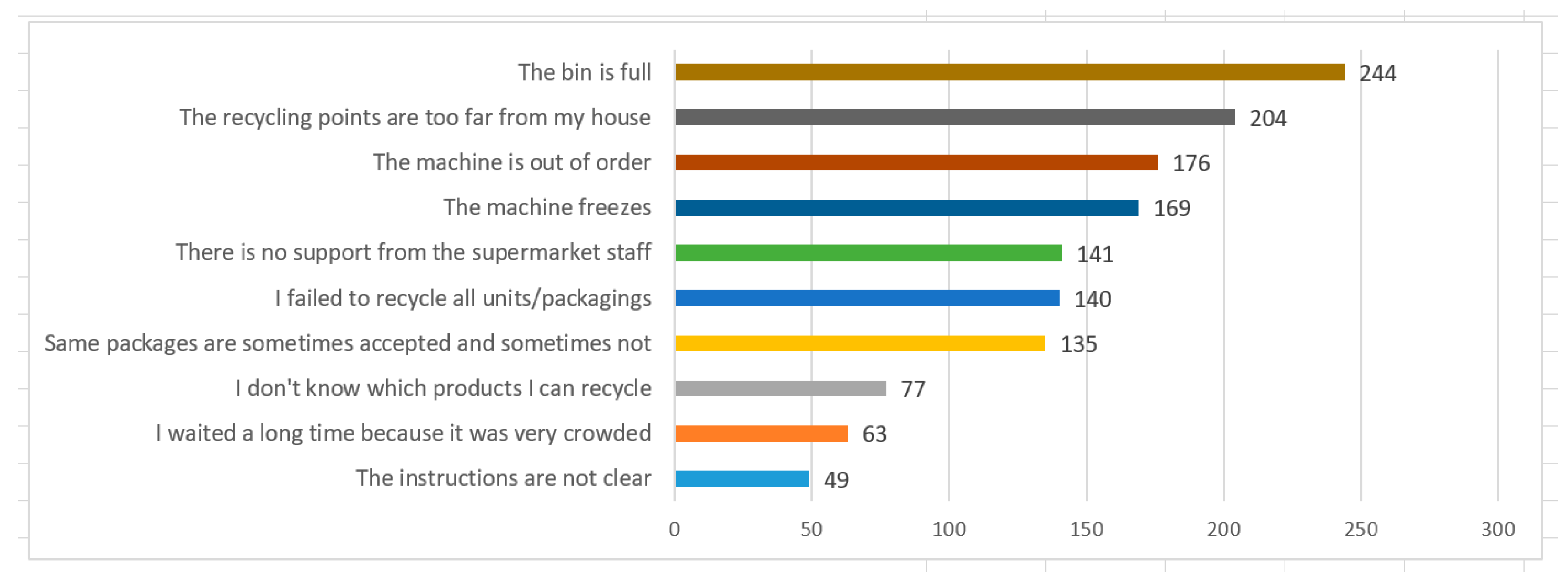
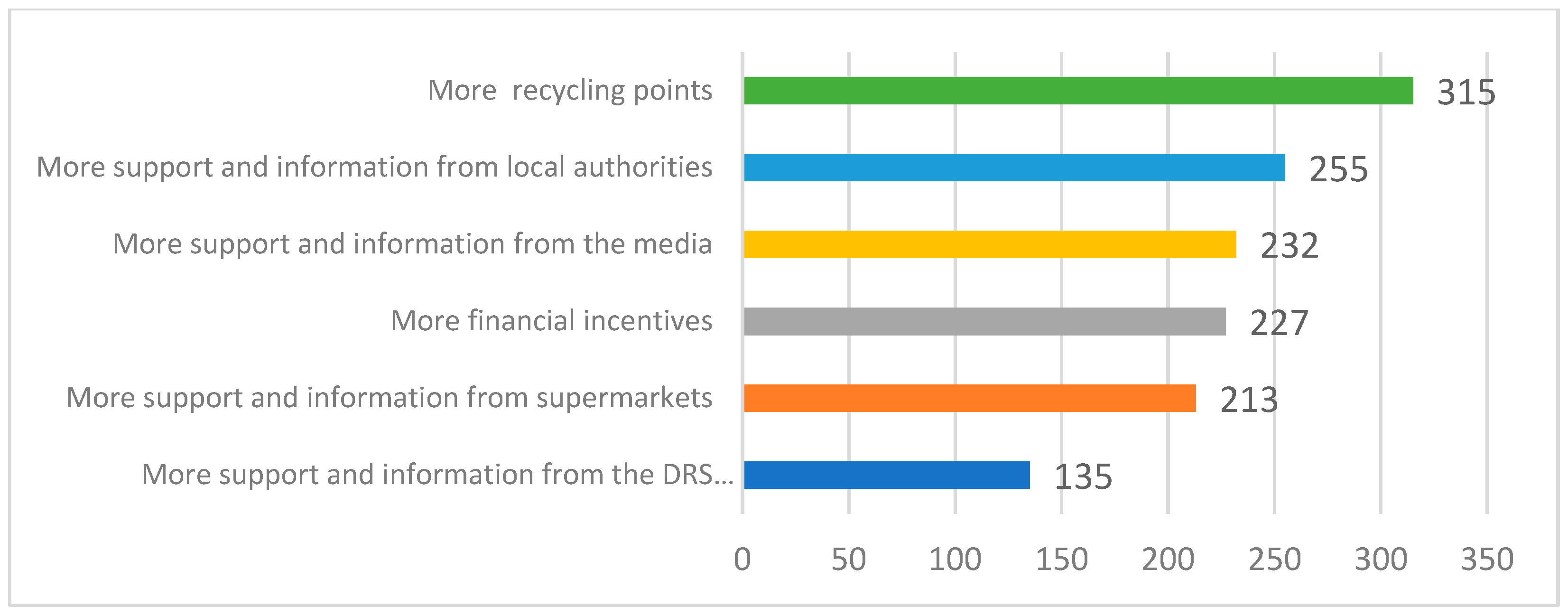
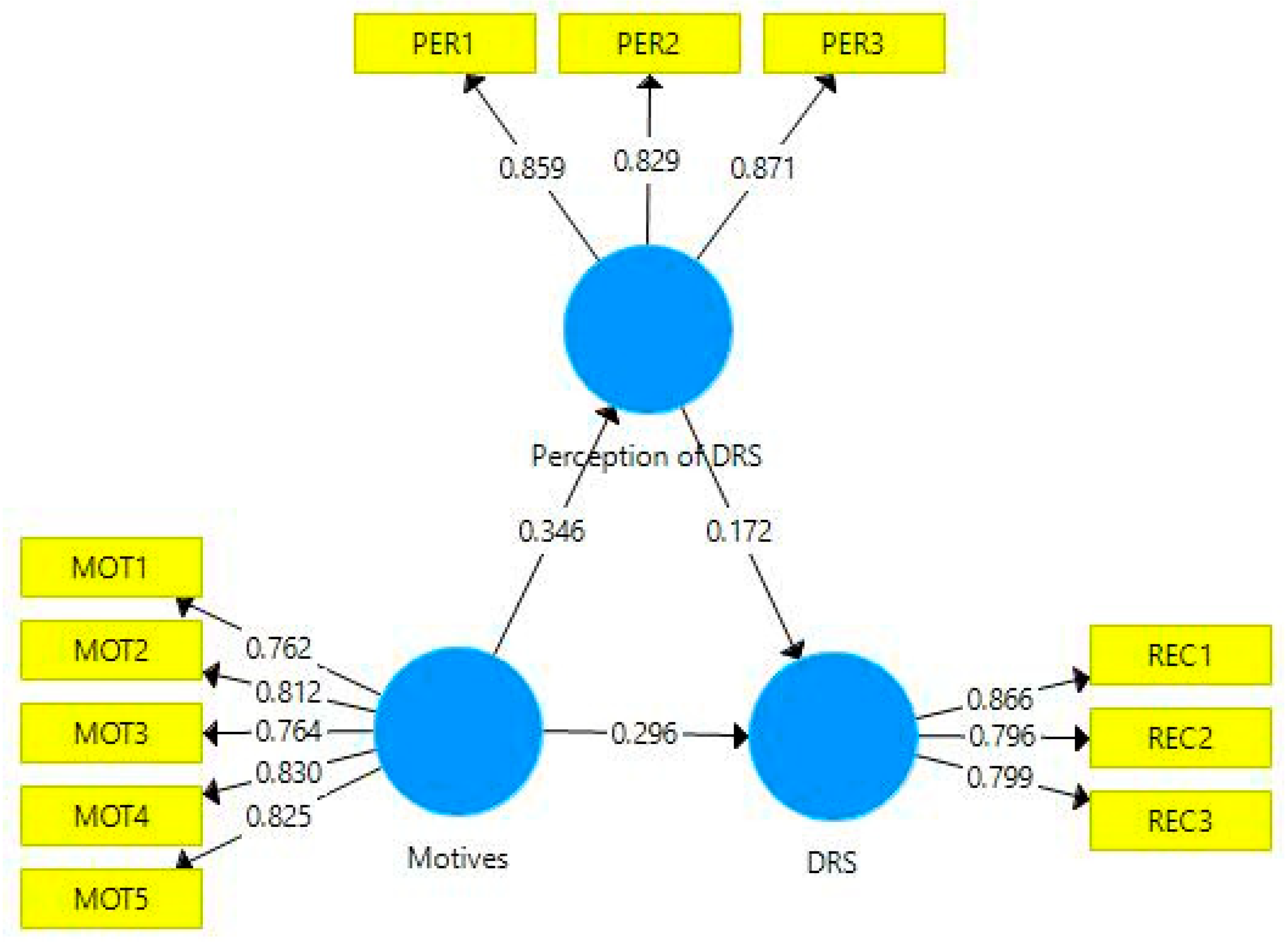
| Gender | N | % |
|---|---|---|
| Male | 279 | 48.3 |
| Female | 299 | 51.7 |
| Age group | ||
| 18–24 | 178 | 30.8 |
| 25–34 | 131 | 22.7 |
| 35–50 | 177 | 30.6 |
| 51–65 | 82 | 14.2 |
| Over 65 | 10 | 1.7 |
| Education level | ||
| High School | 230 | 39.8 |
| Post-secondary non-tertiary education | 106 | 18.3 |
| Bachelor’s degree | 178 | 30.8 |
| MSc/PhD | 64 | 11.1 |
| Marital status | ||
| Unmarried | 318 | 55.0 |
| Married | 260 | 45.0 |
| Employment status | ||
| University student | 151 | 26.1 |
| Unemployed | 59 | 10.2 |
| Private sector employee | 259 | 44.8 |
| Public sector employee | 109 | 18.9 |
| Annual family income | ||
| EUR < 12,000€ | 162 | 28.0 |
| EUR 12,000–23,000 | 267 | 46.2 |
| EUR 24,000–35,0000 | 113 | 19.6 |
| EUR > 35,000 | 36 | 6.2 |
| City | ||
| Athens | 293 | 50.7 |
| Thessaloniki | 175 | 30.3 |
| Larissa | 28 | 4.8 |
| Xanthi | 66 | 11.4 |
| Katerini | 16 | 2.8 |
| Statement (*) | 1 | 2 | 3 | 4 | 5 |
|---|---|---|---|---|---|
| DRS is an easy and pleasant process for me | 2.1 | 13.7 | 21.1 | 47.8 | 15.4 |
| DRS is a process that I do not encounter technical problems | 2.4 | 13.5 | 29.8 | 44.6 | 9.7 |
| DRS is a process that reflects my values about green thinking | 2.1 | 8 | 30.3 | 49.7 | 10 |
| Perception of Refund System | Deposit Refund Recycling | Motives | |
|---|---|---|---|
| Perception of refund system | |||
| Deposit refund recycling | 0.316 | ||
| Motives | 0.408 | 0.412 |
| Path Coefficient | 95% Bca Confidence Interval | Significant (p < 0.05)? | f2 Effect Size | |
|---|---|---|---|---|
| Motives→ Perception of contributory recycling | 0.346 | [0.259, 0.426] | Yes | 0.136 |
| Motives→ Contributory recycling | 0.296 | [0.220, 0.365] | Yes | 0.091 |
| Perception of contributory recycling→ Contributory recycling | 0.172 | [0.079, 0.255] | Yes | 0.031 |
| Motives→ Perception of contributory recycling→ Contributory recycling | 0.059 | Ν/A | Yes | N/A |
| PLS Model | Linear Model | |||
|---|---|---|---|---|
| RMSE | MAE | RMSE | MAE | |
| PER1 | 0.929 | 0.737 | 0.926 | 0.730 |
| PER2 | 0.820 | 0.652 | 0.821 | 0.647 |
| PER3 | 0.890 | 0.720 | 0.893 | 0.723 |
| REC1 | 1.049 | 0.875 | 1.052 | 0.877 |
| REC2 | 1.231 | 1.023 | 1.230 | 1.029 |
| REC3 | 1.187 | 1.001 | 1.186 | 1.003 |
| Latent Variable | Indicators | Convergent Validity | Internal Consistency Reliability | |||
|---|---|---|---|---|---|---|
| Loadings | AVE | Composite Reliability | ρA | Cronbach’s Alpha | ||
| >0.7 | >0.5 | >0.7 | >0.7 | 0.7–0.9 | ||
| Motives | MOT1 | 0.762 | 0.728 | 0.925 | 0.864 | 0.868 |
| MOT2 | 0.825 | |||||
| MOT3 | 0.812 | |||||
| MOT4 | 0.764 | |||||
| MOT5 | 0.762 | |||||
| Perception of contributory recycling | PER1 | 0.871 | 0.728 | 0.889 | 0.822 | 0.814 |
| PER2 | 0.858 | |||||
| PER3 | 0.829 | |||||
| Contributory Recycling | REC1 | 0.868 | 0.674 | 0.861 | 0.864 | 0.768 |
| REC2 | 0.797 | |||||
| REC3 | 0.797 | |||||
Disclaimer/Publisher’s Note: The statements, opinions and data contained in all publications are solely those of the individual author(s) and contributor(s) and not of MDPI and/or the editor(s). MDPI and/or the editor(s) disclaim responsibility for any injury to people or property resulting from any ideas, methods, instructions or products referred to in the content. |
© 2023 by the authors. Licensee MDPI, Basel, Switzerland. This article is an open access article distributed under the terms and conditions of the Creative Commons Attribution (CC BY) license (https://creativecommons.org/licenses/by/4.0/).
Share and Cite
Konstantoglou, A.; Fotiadis, T.; Folinas, D.; Falaras, A.; Rotsios, K. Accessing Consumer Perceptions of the Effectiveness of the Deposit Refund System. Sustainability 2023, 15, 9429. https://doi.org/10.3390/su15129429
Konstantoglou A, Fotiadis T, Folinas D, Falaras A, Rotsios K. Accessing Consumer Perceptions of the Effectiveness of the Deposit Refund System. Sustainability. 2023; 15(12):9429. https://doi.org/10.3390/su15129429
Chicago/Turabian StyleKonstantoglou, Aggeliki, Thomas Fotiadis, Dimitris Folinas, Athanasios Falaras, and Konstantinos Rotsios. 2023. "Accessing Consumer Perceptions of the Effectiveness of the Deposit Refund System" Sustainability 15, no. 12: 9429. https://doi.org/10.3390/su15129429
APA StyleKonstantoglou, A., Fotiadis, T., Folinas, D., Falaras, A., & Rotsios, K. (2023). Accessing Consumer Perceptions of the Effectiveness of the Deposit Refund System. Sustainability, 15(12), 9429. https://doi.org/10.3390/su15129429





